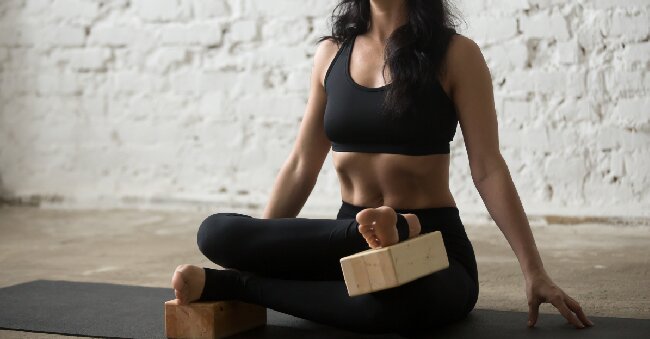
3 Ways Yoga Bricks Transform Your Practice: Deepen Stretches & Enhance Flexibility
Yoga bricks are often underestimated as simple props, but they can have a notable impact on one’s practice. These versatile tools can enhance flexibility, provide support, and help prevent injuries, ultimately elevating the effectiveness of a yoga routine.
This exploration will cover the various types of yoga bricks, their usage, and the advantages they bring. By integrating yoga bricks into a practice, individuals can expand their stretches, improve strength, and introduce diversity into their routine.
What Are Yoga Bricks?
Yoga bricks are versatile accessories that enhance a yoga practice by offering support and stability during different poses and stretches.
These props are beneficial for improving alignment and increasing the depth of stretches, making them valuable tools for yogis of all levels. In yoga practices like Hatha, which emphasize precision and balance, yoga bricks can assist in maintaining correct form and reducing the risk of injuries. In restorative yoga, these props aid in relaxation and facilitating a deeper release. Integrating yoga bricks into a routine can introduce new challenges to the body and enable practitioners to explore poses more comfortably and confidently.
How Are Yoga Bricks Used?
Yoga bricks are commonly used to offer support and alignment for the body in various yoga poses, ensuring correct form and enabling deeper stretches. These adaptable props can be especially advantageous for beginners or individuals with restricted flexibility, as they assist in preventing muscle strain.
Placing the brick under hands, feet, or hips allows practitioners to adjust poses according to their specific requirements, progressively enhancing strength and flexibility. Modifying the height of the brick enables customization, giving practitioners the flexibility to discover a comfortable variation that supports their body while upholding the pose’s integrity.
1. For Support and Alignment
Utilizing yoga bricks for support and alignment can aid in maintaining proper posture by offering added stability and reducing strain on joints.
Yoga bricks are essential for evenly distributing body weight, enabling practitioners to safely enhance their practice. Individuals new to yoga frequently encounter difficulties with alignment in demanding poses, and this is where yoga bricks prove beneficial. By strategically positioning the bricks under hands, feet, or hips, individuals can incrementally develop strength and flexibility, while averting injuries. These props deliver support without undermining the pose’s integrity, rendering it inclusive for participants of varying skill levels to fully appreciate the advantages of yoga practice.
2. To Increase Flexibility
By utilizing yoga bricks in a yoga practice, flexibility can be improved by incrementally expanding the range of motion in stretches and poses.
Yoga bricks function as versatile props, providing support and stability to help safely deepen stretches and experiment with different variations of postures.
For instance, in a seated forward bend, placing a brick under the hands can alleviate tension on the hamstrings and lower back, enabling a deeper fold with proper alignment.
In a supported bridge pose, the use of yoga bricks under the sacrum can raise the hips, creating additional space in the chest and shoulders to enhance flexibility in the spine and hip flexors.
3. To Modify Difficult Poses
Yoga bricks can serve as useful tools for modifying challenging poses by offering added support and stability, enabling individuals to discover variations that align with their specific requirements. These adaptable props are particularly advantageous for novices or those with restricted flexibility, as they assist in attaining correct alignment and minimizing strain on the body.
By integrating yoga bricks into one’s routine, individuals can progressively develop strength and confidence, leading to deeper stretches and improved overall performance. Prioritizing stability and equilibrium, the utilization of yoga bricks enables practitioners to concentrate on proper posture and positioning, decreasing the likelihood of injury and enriching the overall yoga session experience.
What Are the Different Types of Yoga Bricks?
Yoga bricks are available in different materials, such as foam, cork, and wood, each offering specific levels of support and firmness for your yoga practice.
- Foam bricks are lightweight and soft, making them suitable for beginners or individuals in need of gentle support.
- Cork bricks, in contrast, are more durable and provide a firmer surface, offering stability for advanced practitioners.
- Wood bricks are recognized for their durability and natural appearance, providing a strong base for various yoga poses.
Selecting the appropriate type of yoga brick based on your preference and skill level can improve your overall yoga experience, helping you achieve better alignment and balance.
1. Foam Bricks
Foam bricks are lightweight and suitable for beginners or individuals seeking gentle support during yoga practice, as they offer a softer surface compared to other brick materials.
They are well-suited for those looking to gradually enhance their flexibility and strength, providing a comfortable foundation for various poses. The cushioning effect of foam bricks can help alleviate strain on joints and muscles, which can be especially advantageous for individuals with injuries or physical limitations.
In poses like supported bridge or seated forward fold, these bricks can be utilized to bolster the back, hips, and knees, facilitating proper alignment and relaxation. Their versatility enhances the yoga experience, enabling practitioners to adjust poses and achieve comfort in challenging postures.
2. Cork Bricks
Cork bricks are environmentally friendly options that offer firmer support, making them well-suited for advanced practitioners seeking stability and alignment in challenging yoga poses.
These sustainable bricks not only benefit the environment but also provide a solid base for yogis aiming to enhance their practice. By using cork bricks, experienced yogis can feel more rooted and centered when executing challenging postures, enabling them to maintain proper alignment effortlessly.
The natural texture of cork offers a non-slip surface, improving grip and stability, which is essential for sustaining more strenuous yoga poses. Integrating cork bricks into one’s practice can enhance the yoga experience and aid in advancing towards mastering various poses.
3. Wood Bricks
Wood bricks are recognized for their durability and versatility, making them suitable for practitioners of all levels seeking dependable support and alignment aids in their yoga practice. These wooden props are designed to endure the challenges of daily practice and offer stable foundations for a variety of poses, ranging from gentle restorative stretches to advanced balancing postures. Their robust construction ensures long-lasting use, making them a practical investment for yogis in search of equipment that can evolve with their practice over time.
What Are the Benefits of Using Yoga Bricks?
The use of yoga bricks in one’s practice can enhance flexibility, stability, and provide essential support to prevent injuries, enabling individuals to deepen their poses securely.
These versatile props act as extensions of the arms, legs, and spine, helping with accessing challenging poses with ease. Utilizing yoga bricks strategically allows for fine-tuning of alignment, leading to more precise and effective movements. This focus on alignment not only improves the physical advantages of the practice but also fosters mindfulness and body awareness.
Integrating yoga bricks into a routine offers a range of possibilities for variations and modifications, adding dynamism and engagement to the practice.
1. Improves Flexibility and Range of Motion
Using yoga bricks can help improve flexibility and increase the range of motion by engaging key muscles and facilitating a deeper stretch in various poses. Incorporating yoga bricks into a practice provides support and stability during challenging poses, allowing the practitioner to concentrate on proper alignment and posture. This can result in a more efficient workout that targets specific muscle groups, aiding in the development of strength and endurance.
Regular use of yoga bricks can also assist in injury prevention by reducing strain on joints and muscles, making them a valuable tool for individuals at all skill levels. Over time, the enhanced flexibility attained through consistent use of yoga bricks can contribute to overall well-being and physical performance.
2. Increases Stability and Balance
Yoga bricks help to increase stability and balance during yoga practice, helping withdividuals in mastering challenging balance poses by improving body awareness and core strength.
When yoga bricks are incorporated into practice, balance can be enhanced in poses such as Tree Pose by placing a brick under the foot for extra support and improved body alignment. In poses like Half Moon Pose, using a brick can aid in maintaining stability while reaching upwards, enabling focus on engaging core muscles for enhanced balance. These props serve as beneficial tools for developing strength and stability, promoting proper alignment and mindfulness in yoga practice.
3. Provides Support and Prevents Injury
Yoga bricks are valuable tools that provide essential support, help prevent injuries, and are commonly used in physical therapy, rehabilitation, and for maintaining proper alignment during yoga practice.
These props offer stability and added height when necessary, aiding individuals at all fitness levels in achieving correct alignment and posture in a variety of yoga poses. In physical therapy settings, yoga bricks are frequently utilized to facilitate gentle stretching, muscle strengthening, and improvement of balance. Their incorporation into rehabilitation practices allows individuals to effectively target specific muscle groups while minimizing strain on other areas. The versatility of yoga bricks enables modifications in poses and exercises to accommodate individual needs and enhance overall recovery and alignment correction processes.
How Can Yoga Bricks Improve Your Practice?
Yoga bricks can enhance your practice by helping you deepen stretches, improve strength, and explore a wider range of poses that challenge and strengthen your body.
Adding yoga bricks to your practice can offer essential support, allowing you to gradually enhance flexibility and stability. These versatile props assist in maintaining proper alignment in poses, reducing the risk of injuries and enabling you to safely extend your boundaries. By including yoga bricks in your routine, you can experiment with different modifications, making familiar poses more accessible or introducing new challenges. This variety promotes growth and advancement, ensuring that your practice remains engaging and fulfilling. Embrace the transformative potential of yoga bricks and unlock new dimensions in your yoga journey.
1. Deepen Stretches and Poses
Using yoga bricks can help individuals deepen their stretches and poses by providing additional extension and reach, which can assist in unlocking greater flexibility and mobility in their practice.
For example, when performing a seated forward bend, placing a yoga brick in front of the feet can help in reaching further forward, enabling a deeper stretch in the hamstrings and lower back. Additionally, in a supported bridge pose, positioning a yoga brick beneath the sacrum can aid in elevating the hips higher, enhancing the opening of the chest and shoulders.
By incorporating yoga bricks strategically into one’s practice, individuals can ensure proper alignment and gradually progress towards more advanced variations of poses.
2. Help to Build Strength and Endurance
Incorporating yoga bricks into a yoga practice can help enhance strength and endurance by involving specific muscles, especially the core, which can result in improved stability and balance.
By incorporating yoga bricks into exercises, you can target muscles such as the obliques, abdominals, and lower back, intensifying the activation of these areas during poses. The additional resistance from the bricks challenges the muscles, encouraging muscle development and boosting overall strength.
Using yoga bricks in strength-building activities like lunges or squats can amplify the effectiveness of these movements, necessitating increased core engagement to maintain proper posture. This increased involvement leads to greater muscle activation and a more complete workout experience.
3. Allow for Greater Variation and Challenge in Practice
Yoga bricks can be used to introduce greater variation and challenge into a yoga practice, allowing for exploration of new possibilities in seated poses, standing poses, and other postures.
For seated poses, a yoga brick can be placed between the knees in poses like Bound Angle Pose to engage the inner thighs. In standing poses, bricks can be utilized to bring the floor closer in poses like Half Moon Pose or Triangle Pose to enhance stability.
Various modifications can be made by using half or full bricks beneath the palms in poses like Plank Pose to intensify core engagement. The versatility of yoga bricks enables practitioners to adjust the intensity of each pose, making them a useful tool for individuals at all levels of yoga practice.




No Comments